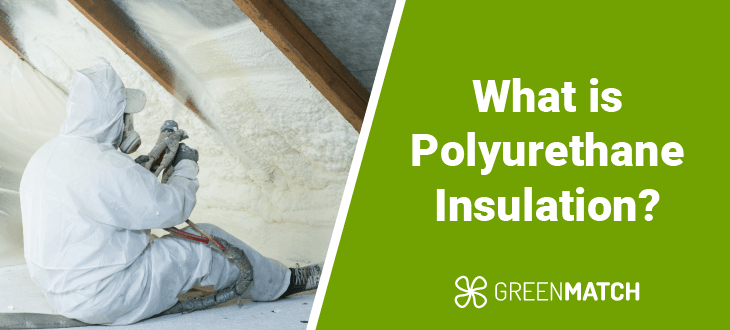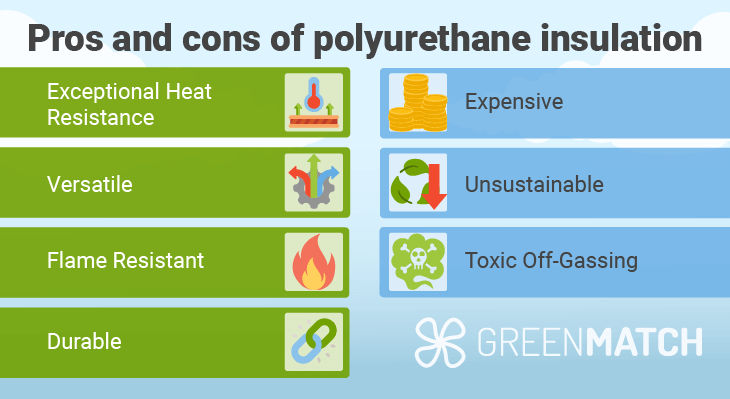Answer these simple questions and we will find you the BEST prices
Which type of solar quotes do you need?
It only takes 30 seconds
100% free with no obligation

Get Free quotes from insulation specialists near you

Save money by comparing quotes and choosing the most competitive offer

The service is 100% free and with no obligation
- GreenMatch
- Insulation
- Insulation Materials
- Polyurethane Insulation
Polyurethane Insulation: Types, Pros and Cons, Costs


- Polyurethane is an expanding foam commonly called polyurethane insulation or spray foam. It can also be found as rigid insulation boards (PUR) or polyisocyanurate boards (PIR).
- As spray foam, polyurethane costs around £21.5 per m2, and PUR insulation board costs £5 – £15 per m2.
- While having a high r-value and exceptional heat retention, polyurethane foam is not the most environmentally sustainable insulation material.
Polyurethane is a class of synthetic polymers that are commonly used to make a variety of insulation materials. Given its wide range of starting materials, polyurethane can be made into a spray foam of different consistencies and rigid insulation boards.
Notably, polyurethane insulation products exhibit exceptional heat retention properties, with an impressive r-value range of 3.6 - 4.5 m²K/W, making them some of the most effective on the market today. However, its synthetic nature and unsustainable production raise some equally worth exploring concerns.
This ultimate guide by GreenMatch UK aims to do just that. This article will cover everything you need about polyurethane-derived insulation products, their applications, pros, cons and costs.
Looking to insulate your home? Let GreenMatch UK be your one-stop solution for the best bargains. By filling out our 30-second online survey, you can get 3 free home-tailored quotes from our nationwide network of trusted installers. No charges, no obligations. Click the button below to begin!
- Describe your needs
- Get free quotes
- Choose the best offer
It only takes 30 seconds



What is polyurethane insulation?
Polyurethane insulation is simply insulation products that derive from synthetic polyurethane. The fact that polyurethane utilises a wide range of base materials means that it can be formed into several different material consistencies such as spray foam, rigid boards, or sheets.
The most popular pu insulation materials are polyurethane spray foam, and rigid insulation boards (PUR or PIR).
What is PIR and PUR insulation?
While both derive from polyurethane as the main material, PIR insulation and PUR insulation boards have a slight difference to them. PIR stands for polyisocyanurate, which is a derivative material that has all that PUR offers, but builds upon it further.
Polyisocyanurate (PIR) boards exhibit exceptional heat resistance, flame and smoke resistance, as well as the same low-moisture barrier properties that PUR boards do.
Applications of polyurethane insulation
Given that polyurethane can either be applied as a spray foam or rigid insulation board, it makes it a versatile material that can be suitable for almost any home insulation application.
Polyurethane spray foam insulation is most notably used for cavity walls, basement ceilings, underfloors and loft insulation. However, the incredibly rigid nature of PU foam insulation makes it difficult to remove, often becoming a very costly and complex process down the line.
Polyurethane spray foam in small applications also works as a perfect airtight seal for door and window frames, effectively stopping draught in a home. The same goes for roof insulation.
On the other hand, rigid PUR and PIR boards can also fit a range of home insulation jobs, such as external and internal wall insulation, roof rafters, solid concrete floors and more.
Pros and cons of polyurethane insulation

Polyurethane-derived insulation materials have plenty of pros and cons to consider. While they may be exceptionally effective, it goes without saying that some concerns with their sustainability and safety should filter into your decision.
Let’s start by exploring some of the main perks of polyurethane-based insulation materials:
- Exceptional heat resistance: Polyurethane insulation products boast some of the best heat retention capabilities on the market today, reaching exceptional R-values of 3.6 - 4.5 m²K/W. As a result, you will save much higher on energy costs, reduce your carbon footprint significantly, and enjoy a temperature-regulated home.
- Versatile: The malleable nature of polyurethane allows it to be made into several different forms, suited for different insulation purposes. Polyurethane can be applied as a spray foam, or rigid insulation boards and sheets.
- Flame resistant: Particularly PIR boards have exceptional flame and smoke resistance, far better than PUR boards. This makes it a long-term safer option in terms of minimising fire risk.
- Durable: Polyurethane, both when applied as spray foam or as rigid boards - is extremely durable and weatherproof, giving it one of the longest lifespans of any insulation material.
With the pros in account, it’s also important to reflect on some of the key downsides that come with polyurethane-based insulation materials. Here are some of the key ones:
- Expensive: Polyurethane-based insulation materials are certainly not cheap, sometimes costing more than double your traditional fibreglass and mineral wool insulation. Granted, they are more thermally efficient, but not everyone can afford the high price tag.
- Unsustainable: Polyurethane is a synthetic polymer that consumes a lot of energy to produce and recycle. It is also not possible to discard polyurethane products as they do not degrade or compost.
- Toxic off-gassing: Polyurethane foam runs a high risk of releasing toxic fumes and volatile organic compounds (VOCs) during and after installation. These fumes can cause respiratory issues and are very harmful to the environment.
Looking at the various pros and cons, it's important to ask yourself what you aim for when looking for suitable insulation. It’s recommended to work with a professional installer who can conduct a house assessment and present to you your alternative options as well.
Polyurethane insulation cost
In general, polyurethane spray foam costs around £21.5 per m2 of application, while PUR and PIR insulation boards can cost £5 – £15 per m2, with PIR boards tending to cost a bit more.
Like any insulation material, your final investment will hinge on several factors, such as your chosen insulation manufacturer, density and thermal efficiency, home type, job complexity and size of insulation needed amongst many more.
While these costs may be high, certain households can qualify for free insulation through a UK grant scheme. The two main schemes currently available are the Great British Insulation Scheme (GBIS) and the Energy Company Obligation (ECO4).
Find trusted polyurethane insulation installers near you
Working with a material like polyurethane, especially as a spray foam, will most definitely require an industry expert to carry out. This is because the material itself can be toxic, but also a poor insulation job can damage your property irreversibly.
That’s why it’s important to work with a professional accredited installer to ensure decades of home comfort, instead of decades of burdensome repair costs. However, not everybody has endless hours to spend researching and vetting installers to find the right fit. That’s where GreenMAtch UK comes in.
Through our services, you can receive up to 3 free home-tailored quotes from our nationwide network of pre-vetted installers, completely free of charge. All you have to do is fill out our simple 30-second online form and let the bargains come to you. Click the button below to begin!
- Describe your needs
- Get free quotes
- Choose the best offer
It only takes 30 seconds



FAQ
Polyurethane-based insulation materials can indeed be used for insulation. They can be found in the form of spray foam, rigid boards or sheets.
From a thermal efficiency perspective, polyurethane is a great insulator, exhibiting some of the most impressive thermal retention properties available today. From a sustainability and safety standpoint, polyurethane is quite damaging to the environment and personal health.
Polyurethane-based insulation materials tend to be very expensive, unsustainable to produce, environmentally detrimental to discard and potentially can off-gas harmful toxins and fumes during and after installation.

Akif is a copywriter at GreenMatch since 2023. With a keen interest in community sustainability, green solutions and the role of digital media in identifying climate trends, he aims to hone in on his background in International Studies and Digital Media to provide a multidisciplinary approach to written content rooted in credible research and accuracy.
We strive to connect our customers with the right product and supplier. Would you like to be part of GreenMatch?

